Management of Pain and Nutritional Requirement in Ulcerative Colitis: A Case Study
VerifiedAdded on 2023/06/03
|6
|2411
|305
AI Summary
This assignment discusses the management of pain in ulcerative colitis and the role of a registered dietician in assessing the nutritional requirement of the patient. It also provides a case study on Bob Jackson's multidisciplinary care approach. The report describes the effects of each medication and provides an in-depth discussion regarding the role of diet in managing the symptoms of ulcerative colitis.
Contribute Materials
Your contribution can guide someone’s learning journey. Share your
documents today.
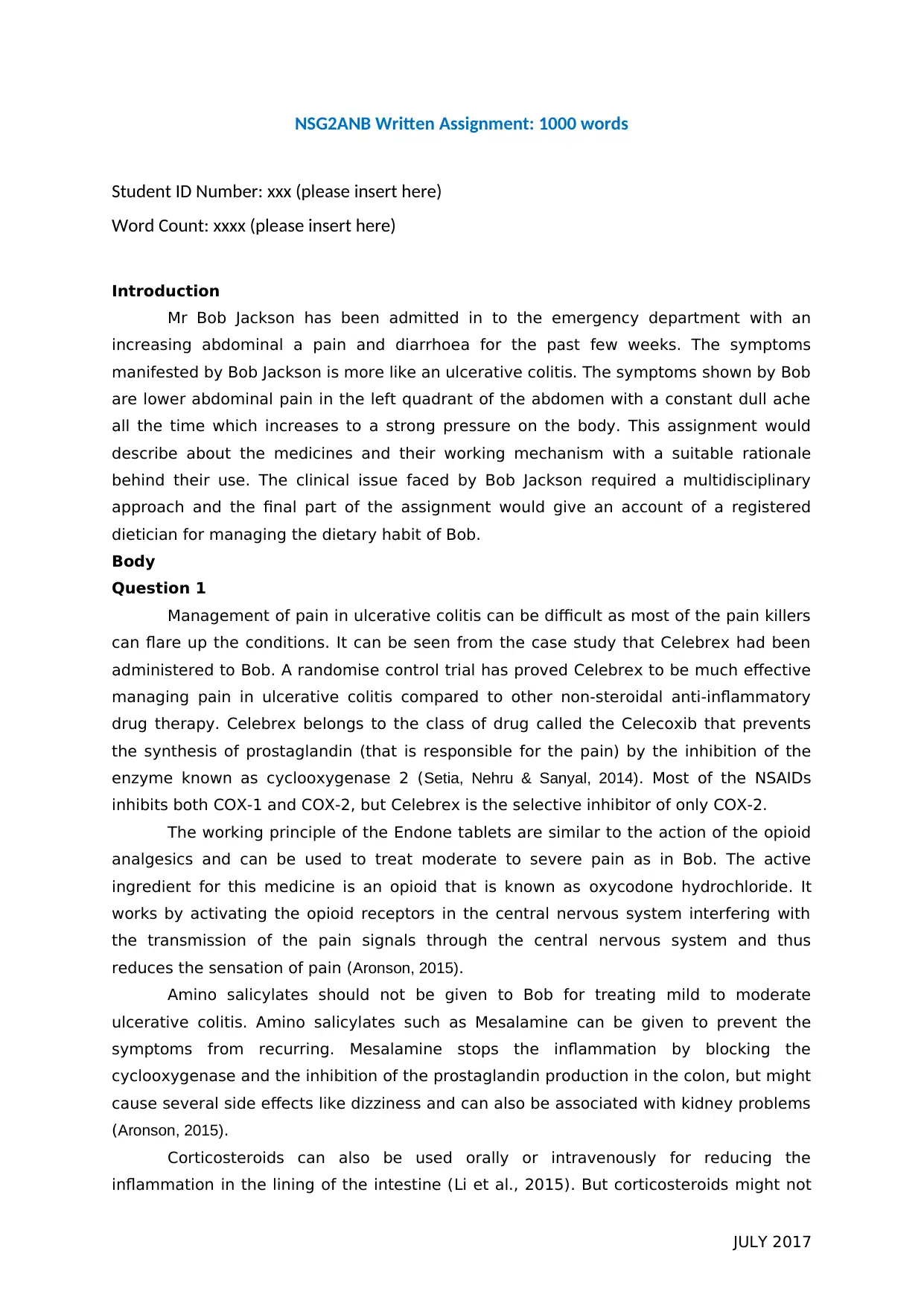
NSG2ANB Written Assignment: 1000 words
Student ID Number: xxx (please insert here)
Word Count: xxxx (please insert here)
Introduction
Mr Bob Jackson has been admitted in to the emergency department with an
increasing abdominal a pain and diarrhoea for the past few weeks. The symptoms
manifested by Bob Jackson is more like an ulcerative colitis. The symptoms shown by Bob
are lower abdominal pain in the left quadrant of the abdomen with a constant dull ache
all the time which increases to a strong pressure on the body. This assignment would
describe about the medicines and their working mechanism with a suitable rationale
behind their use. The clinical issue faced by Bob Jackson required a multidisciplinary
approach and the final part of the assignment would give an account of a registered
dietician for managing the dietary habit of Bob.
Body
Question 1
Management of pain in ulcerative colitis can be difficult as most of the pain killers
can flare up the conditions. It can be seen from the case study that Celebrex had been
administered to Bob. A randomise control trial has proved Celebrex to be much effective
managing pain in ulcerative colitis compared to other non-steroidal anti-inflammatory
drug therapy. Celebrex belongs to the class of drug called the Celecoxib that prevents
the synthesis of prostaglandin (that is responsible for the pain) by the inhibition of the
enzyme known as cyclooxygenase 2 (Setia, Nehru & Sanyal, 2014). Most of the NSAIDs
inhibits both COX-1 and COX-2, but Celebrex is the selective inhibitor of only COX-2.
The working principle of the Endone tablets are similar to the action of the opioid
analgesics and can be used to treat moderate to severe pain as in Bob. The active
ingredient for this medicine is an opioid that is known as oxycodone hydrochloride. It
works by activating the opioid receptors in the central nervous system interfering with
the transmission of the pain signals through the central nervous system and thus
reduces the sensation of pain (Aronson, 2015).
Amino salicylates should not be given to Bob for treating mild to moderate
ulcerative colitis. Amino salicylates such as Mesalamine can be given to prevent the
symptoms from recurring. Mesalamine stops the inflammation by blocking the
cyclooxygenase and the inhibition of the prostaglandin production in the colon, but might
cause several side effects like dizziness and can also be associated with kidney problems
(Aronson, 2015).
Corticosteroids can also be used orally or intravenously for reducing the
inflammation in the lining of the intestine (Li et al., 2015). But corticosteroids might not
JULY 2017
Student ID Number: xxx (please insert here)
Word Count: xxxx (please insert here)
Introduction
Mr Bob Jackson has been admitted in to the emergency department with an
increasing abdominal a pain and diarrhoea for the past few weeks. The symptoms
manifested by Bob Jackson is more like an ulcerative colitis. The symptoms shown by Bob
are lower abdominal pain in the left quadrant of the abdomen with a constant dull ache
all the time which increases to a strong pressure on the body. This assignment would
describe about the medicines and their working mechanism with a suitable rationale
behind their use. The clinical issue faced by Bob Jackson required a multidisciplinary
approach and the final part of the assignment would give an account of a registered
dietician for managing the dietary habit of Bob.
Body
Question 1
Management of pain in ulcerative colitis can be difficult as most of the pain killers
can flare up the conditions. It can be seen from the case study that Celebrex had been
administered to Bob. A randomise control trial has proved Celebrex to be much effective
managing pain in ulcerative colitis compared to other non-steroidal anti-inflammatory
drug therapy. Celebrex belongs to the class of drug called the Celecoxib that prevents
the synthesis of prostaglandin (that is responsible for the pain) by the inhibition of the
enzyme known as cyclooxygenase 2 (Setia, Nehru & Sanyal, 2014). Most of the NSAIDs
inhibits both COX-1 and COX-2, but Celebrex is the selective inhibitor of only COX-2.
The working principle of the Endone tablets are similar to the action of the opioid
analgesics and can be used to treat moderate to severe pain as in Bob. The active
ingredient for this medicine is an opioid that is known as oxycodone hydrochloride. It
works by activating the opioid receptors in the central nervous system interfering with
the transmission of the pain signals through the central nervous system and thus
reduces the sensation of pain (Aronson, 2015).
Amino salicylates should not be given to Bob for treating mild to moderate
ulcerative colitis. Amino salicylates such as Mesalamine can be given to prevent the
symptoms from recurring. Mesalamine stops the inflammation by blocking the
cyclooxygenase and the inhibition of the prostaglandin production in the colon, but might
cause several side effects like dizziness and can also be associated with kidney problems
(Aronson, 2015).
Corticosteroids can also be used orally or intravenously for reducing the
inflammation in the lining of the intestine (Li et al., 2015). But corticosteroids might not
JULY 2017
Secure Best Marks with AI Grader
Need help grading? Try our AI Grader for instant feedback on your assignments.
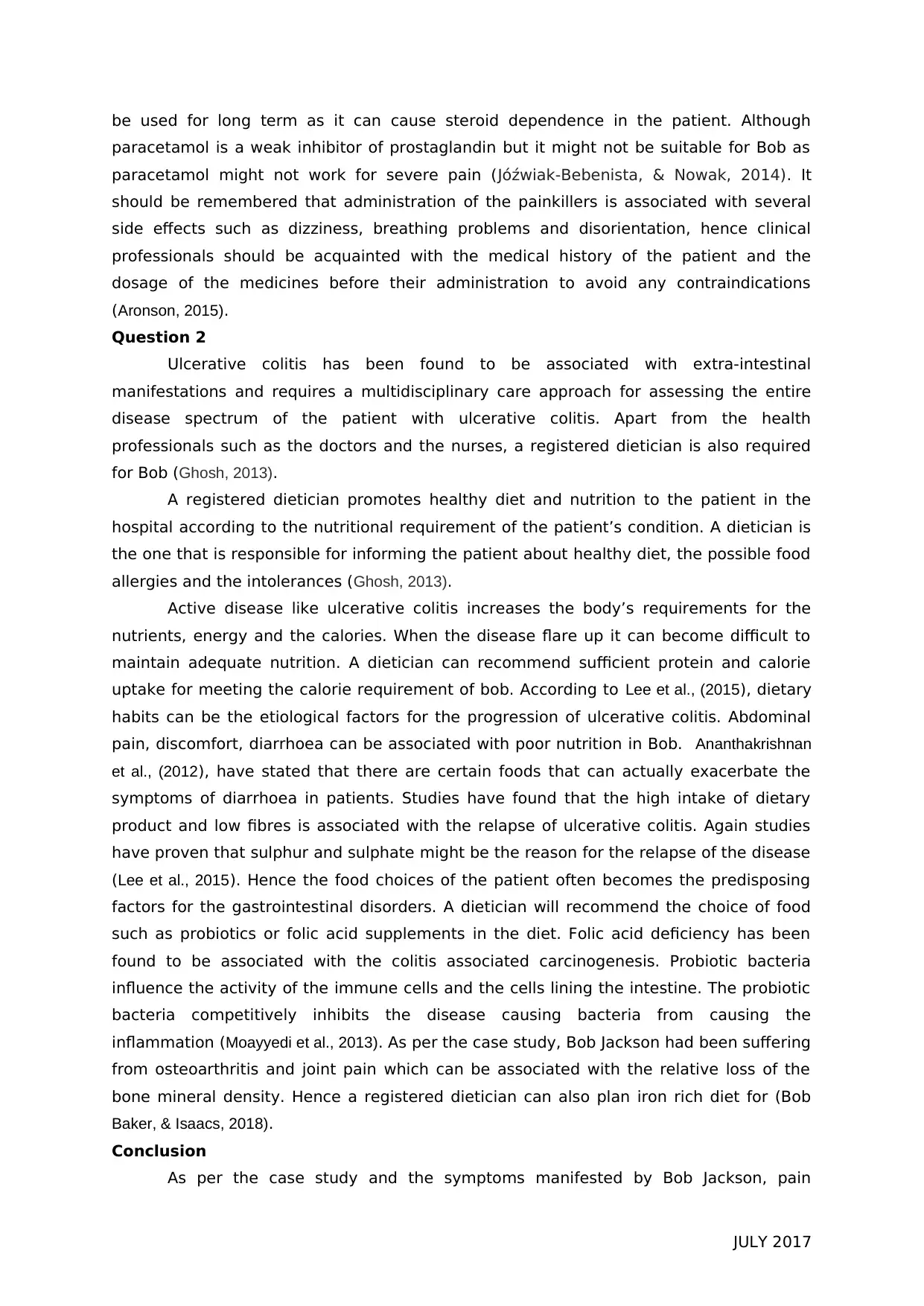
be used for long term as it can cause steroid dependence in the patient. Although
paracetamol is a weak inhibitor of prostaglandin but it might not be suitable for Bob as
paracetamol might not work for severe pain (Jóźwiak-Bebenista, & Nowak, 2014). It
should be remembered that administration of the painkillers is associated with several
side effects such as dizziness, breathing problems and disorientation, hence clinical
professionals should be acquainted with the medical history of the patient and the
dosage of the medicines before their administration to avoid any contraindications
(Aronson, 2015).
Question 2
Ulcerative colitis has been found to be associated with extra-intestinal
manifestations and requires a multidisciplinary care approach for assessing the entire
disease spectrum of the patient with ulcerative colitis. Apart from the health
professionals such as the doctors and the nurses, a registered dietician is also required
for Bob (Ghosh, 2013).
A registered dietician promotes healthy diet and nutrition to the patient in the
hospital according to the nutritional requirement of the patient’s condition. A dietician is
the one that is responsible for informing the patient about healthy diet, the possible food
allergies and the intolerances (Ghosh, 2013).
Active disease like ulcerative colitis increases the body’s requirements for the
nutrients, energy and the calories. When the disease flare up it can become difficult to
maintain adequate nutrition. A dietician can recommend sufficient protein and calorie
uptake for meeting the calorie requirement of bob. According to Lee et al., (2015), dietary
habits can be the etiological factors for the progression of ulcerative colitis. Abdominal
pain, discomfort, diarrhoea can be associated with poor nutrition in Bob. Ananthakrishnan
et al., (2012), have stated that there are certain foods that can actually exacerbate the
symptoms of diarrhoea in patients. Studies have found that the high intake of dietary
product and low fibres is associated with the relapse of ulcerative colitis. Again studies
have proven that sulphur and sulphate might be the reason for the relapse of the disease
(Lee et al., 2015). Hence the food choices of the patient often becomes the predisposing
factors for the gastrointestinal disorders. A dietician will recommend the choice of food
such as probiotics or folic acid supplements in the diet. Folic acid deficiency has been
found to be associated with the colitis associated carcinogenesis. Probiotic bacteria
influence the activity of the immune cells and the cells lining the intestine. The probiotic
bacteria competitively inhibits the disease causing bacteria from causing the
inflammation (Moayyedi et al., 2013). As per the case study, Bob Jackson had been suffering
from osteoarthritis and joint pain which can be associated with the relative loss of the
bone mineral density. Hence a registered dietician can also plan iron rich diet for (Bob
Baker, & Isaacs, 2018).
Conclusion
As per the case study and the symptoms manifested by Bob Jackson, pain
JULY 2017
paracetamol is a weak inhibitor of prostaglandin but it might not be suitable for Bob as
paracetamol might not work for severe pain (Jóźwiak-Bebenista, & Nowak, 2014). It
should be remembered that administration of the painkillers is associated with several
side effects such as dizziness, breathing problems and disorientation, hence clinical
professionals should be acquainted with the medical history of the patient and the
dosage of the medicines before their administration to avoid any contraindications
(Aronson, 2015).
Question 2
Ulcerative colitis has been found to be associated with extra-intestinal
manifestations and requires a multidisciplinary care approach for assessing the entire
disease spectrum of the patient with ulcerative colitis. Apart from the health
professionals such as the doctors and the nurses, a registered dietician is also required
for Bob (Ghosh, 2013).
A registered dietician promotes healthy diet and nutrition to the patient in the
hospital according to the nutritional requirement of the patient’s condition. A dietician is
the one that is responsible for informing the patient about healthy diet, the possible food
allergies and the intolerances (Ghosh, 2013).
Active disease like ulcerative colitis increases the body’s requirements for the
nutrients, energy and the calories. When the disease flare up it can become difficult to
maintain adequate nutrition. A dietician can recommend sufficient protein and calorie
uptake for meeting the calorie requirement of bob. According to Lee et al., (2015), dietary
habits can be the etiological factors for the progression of ulcerative colitis. Abdominal
pain, discomfort, diarrhoea can be associated with poor nutrition in Bob. Ananthakrishnan
et al., (2012), have stated that there are certain foods that can actually exacerbate the
symptoms of diarrhoea in patients. Studies have found that the high intake of dietary
product and low fibres is associated with the relapse of ulcerative colitis. Again studies
have proven that sulphur and sulphate might be the reason for the relapse of the disease
(Lee et al., 2015). Hence the food choices of the patient often becomes the predisposing
factors for the gastrointestinal disorders. A dietician will recommend the choice of food
such as probiotics or folic acid supplements in the diet. Folic acid deficiency has been
found to be associated with the colitis associated carcinogenesis. Probiotic bacteria
influence the activity of the immune cells and the cells lining the intestine. The probiotic
bacteria competitively inhibits the disease causing bacteria from causing the
inflammation (Moayyedi et al., 2013). As per the case study, Bob Jackson had been suffering
from osteoarthritis and joint pain which can be associated with the relative loss of the
bone mineral density. Hence a registered dietician can also plan iron rich diet for (Bob
Baker, & Isaacs, 2018).
Conclusion
As per the case study and the symptoms manifested by Bob Jackson, pain
JULY 2017
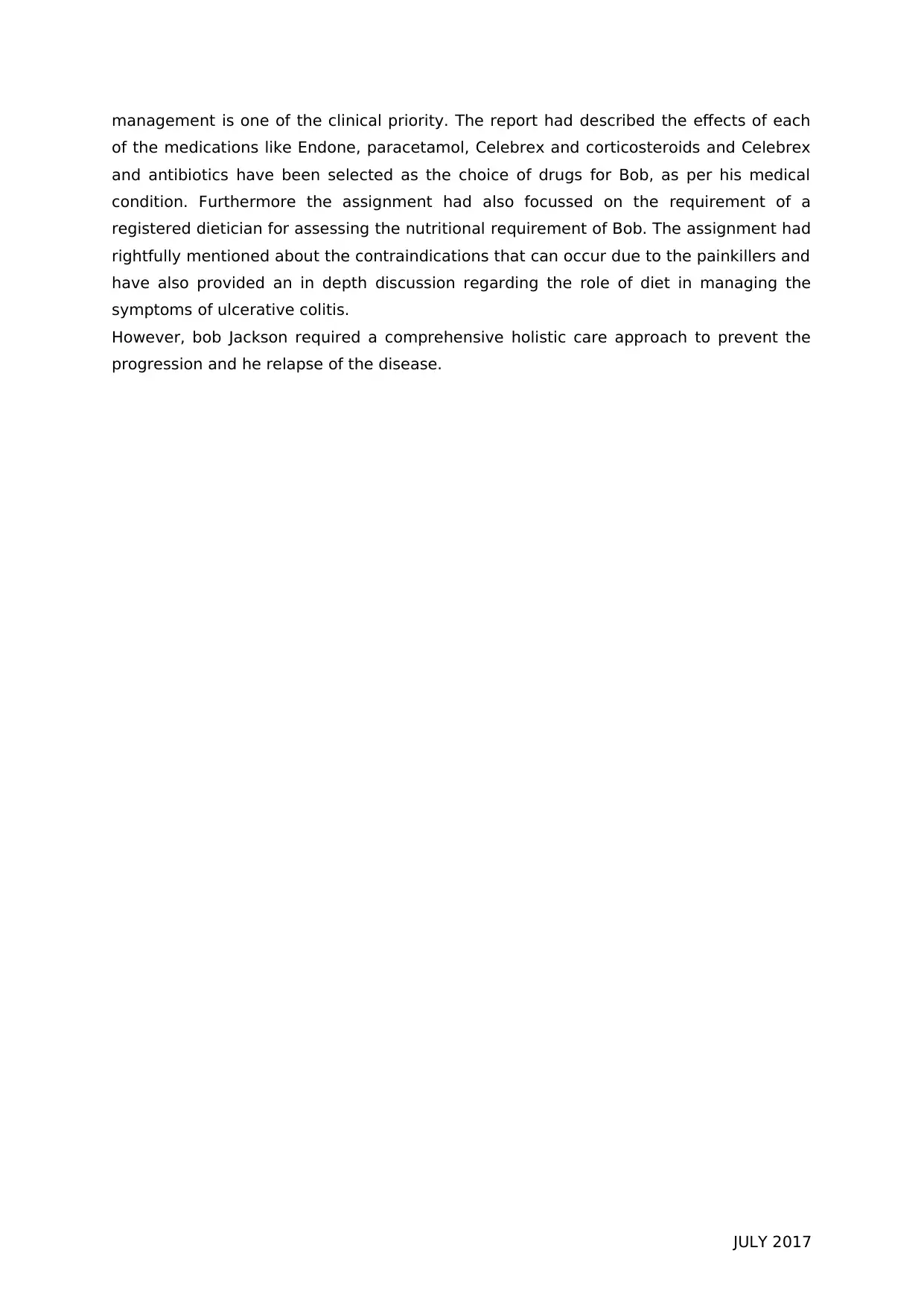
management is one of the clinical priority. The report had described the effects of each
of the medications like Endone, paracetamol, Celebrex and corticosteroids and Celebrex
and antibiotics have been selected as the choice of drugs for Bob, as per his medical
condition. Furthermore the assignment had also focussed on the requirement of a
registered dietician for assessing the nutritional requirement of Bob. The assignment had
rightfully mentioned about the contraindications that can occur due to the painkillers and
have also provided an in depth discussion regarding the role of diet in managing the
symptoms of ulcerative colitis.
However, bob Jackson required a comprehensive holistic care approach to prevent the
progression and he relapse of the disease.
JULY 2017
of the medications like Endone, paracetamol, Celebrex and corticosteroids and Celebrex
and antibiotics have been selected as the choice of drugs for Bob, as per his medical
condition. Furthermore the assignment had also focussed on the requirement of a
registered dietician for assessing the nutritional requirement of Bob. The assignment had
rightfully mentioned about the contraindications that can occur due to the painkillers and
have also provided an in depth discussion regarding the role of diet in managing the
symptoms of ulcerative colitis.
However, bob Jackson required a comprehensive holistic care approach to prevent the
progression and he relapse of the disease.
JULY 2017
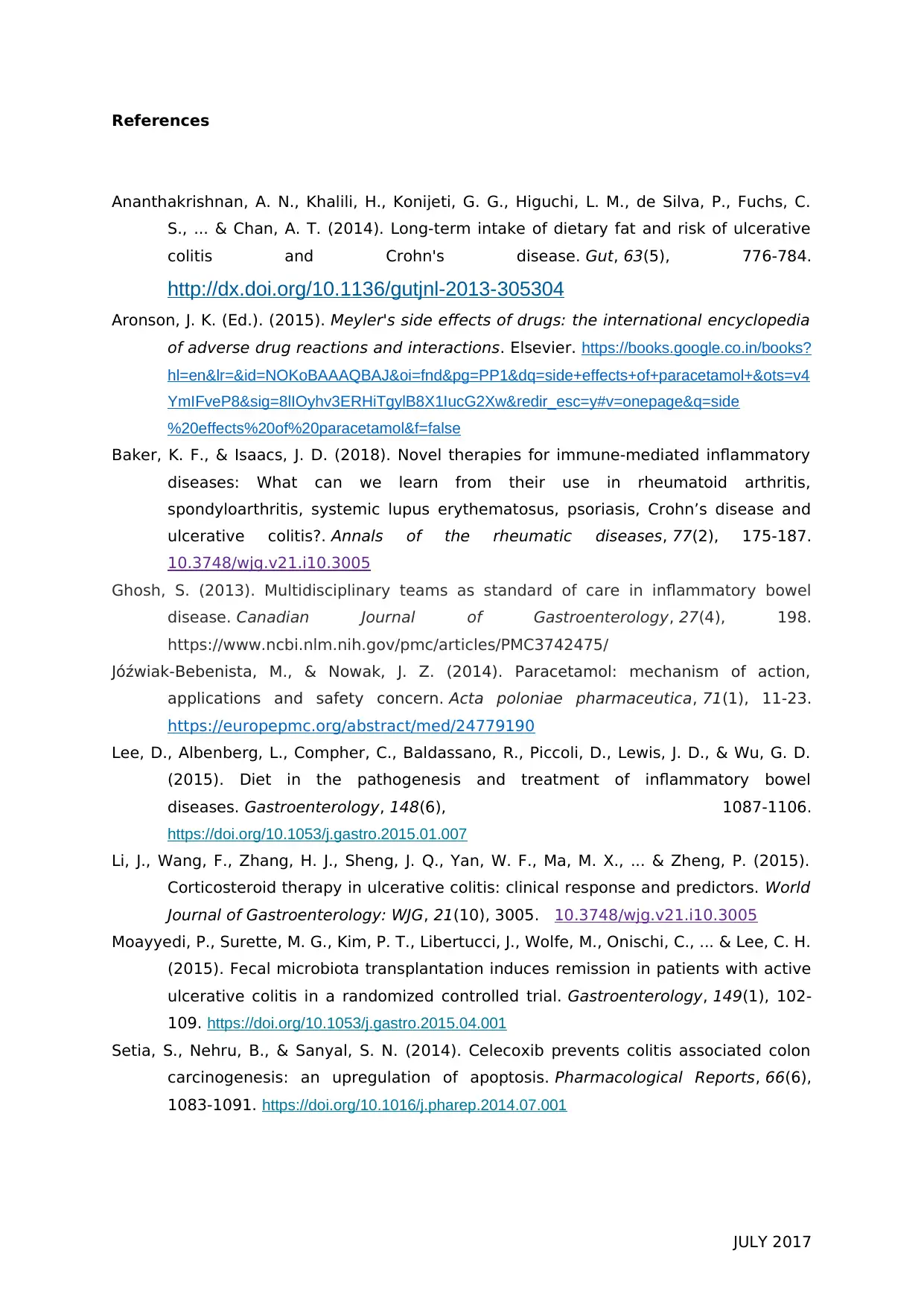
References
Ananthakrishnan, A. N., Khalili, H., Konijeti, G. G., Higuchi, L. M., de Silva, P., Fuchs, C.
S., ... & Chan, A. T. (2014). Long-term intake of dietary fat and risk of ulcerative
colitis and Crohn's disease. Gut, 63(5), 776-784.
http://dx.doi.org/10.1136/gutjnl-2013-305304
Aronson, J. K. (Ed.). (2015). Meyler's side effects of drugs: the international encyclopedia
of adverse drug reactions and interactions. Elsevier. https://books.google.co.in/books?
hl=en&lr=&id=NOKoBAAAQBAJ&oi=fnd&pg=PP1&dq=side+effects+of+paracetamol+&ots=v4
YmIFveP8&sig=8lIOyhv3ERHiTgylB8X1IucG2Xw&redir_esc=y#v=onepage&q=side
%20effects%20of%20paracetamol&f=false
Baker, K. F., & Isaacs, J. D. (2018). Novel therapies for immune-mediated inflammatory
diseases: What can we learn from their use in rheumatoid arthritis,
spondyloarthritis, systemic lupus erythematosus, psoriasis, Crohn’s disease and
ulcerative colitis?. Annals of the rheumatic diseases, 77(2), 175-187.
10.3748/wjg.v21.i10.3005
Ghosh, S. (2013). Multidisciplinary teams as standard of care in inflammatory bowel
disease. Canadian Journal of Gastroenterology, 27(4), 198.
https://www.ncbi.nlm.nih.gov/pmc/articles/PMC3742475/
Jóźwiak-Bebenista, M., & Nowak, J. Z. (2014). Paracetamol: mechanism of action,
applications and safety concern. Acta poloniae pharmaceutica, 71(1), 11-23.
https://europepmc.org/abstract/med/24779190
Lee, D., Albenberg, L., Compher, C., Baldassano, R., Piccoli, D., Lewis, J. D., & Wu, G. D.
(2015). Diet in the pathogenesis and treatment of inflammatory bowel
diseases. Gastroenterology, 148(6), 1087-1106.
https://doi.org/10.1053/j.gastro.2015.01.007
Li, J., Wang, F., Zhang, H. J., Sheng, J. Q., Yan, W. F., Ma, M. X., ... & Zheng, P. (2015).
Corticosteroid therapy in ulcerative colitis: clinical response and predictors. World
Journal of Gastroenterology: WJG, 21(10), 3005. 10.3748/wjg.v21.i10.3005
Moayyedi, P., Surette, M. G., Kim, P. T., Libertucci, J., Wolfe, M., Onischi, C., ... & Lee, C. H.
(2015). Fecal microbiota transplantation induces remission in patients with active
ulcerative colitis in a randomized controlled trial. Gastroenterology, 149(1), 102-
109. https://doi.org/10.1053/j.gastro.2015.04.001
Setia, S., Nehru, B., & Sanyal, S. N. (2014). Celecoxib prevents colitis associated colon
carcinogenesis: an upregulation of apoptosis. Pharmacological Reports, 66(6),
1083-1091. https://doi.org/10.1016/j.pharep.2014.07.001
JULY 2017
Ananthakrishnan, A. N., Khalili, H., Konijeti, G. G., Higuchi, L. M., de Silva, P., Fuchs, C.
S., ... & Chan, A. T. (2014). Long-term intake of dietary fat and risk of ulcerative
colitis and Crohn's disease. Gut, 63(5), 776-784.
http://dx.doi.org/10.1136/gutjnl-2013-305304
Aronson, J. K. (Ed.). (2015). Meyler's side effects of drugs: the international encyclopedia
of adverse drug reactions and interactions. Elsevier. https://books.google.co.in/books?
hl=en&lr=&id=NOKoBAAAQBAJ&oi=fnd&pg=PP1&dq=side+effects+of+paracetamol+&ots=v4
YmIFveP8&sig=8lIOyhv3ERHiTgylB8X1IucG2Xw&redir_esc=y#v=onepage&q=side
%20effects%20of%20paracetamol&f=false
Baker, K. F., & Isaacs, J. D. (2018). Novel therapies for immune-mediated inflammatory
diseases: What can we learn from their use in rheumatoid arthritis,
spondyloarthritis, systemic lupus erythematosus, psoriasis, Crohn’s disease and
ulcerative colitis?. Annals of the rheumatic diseases, 77(2), 175-187.
10.3748/wjg.v21.i10.3005
Ghosh, S. (2013). Multidisciplinary teams as standard of care in inflammatory bowel
disease. Canadian Journal of Gastroenterology, 27(4), 198.
https://www.ncbi.nlm.nih.gov/pmc/articles/PMC3742475/
Jóźwiak-Bebenista, M., & Nowak, J. Z. (2014). Paracetamol: mechanism of action,
applications and safety concern. Acta poloniae pharmaceutica, 71(1), 11-23.
https://europepmc.org/abstract/med/24779190
Lee, D., Albenberg, L., Compher, C., Baldassano, R., Piccoli, D., Lewis, J. D., & Wu, G. D.
(2015). Diet in the pathogenesis and treatment of inflammatory bowel
diseases. Gastroenterology, 148(6), 1087-1106.
https://doi.org/10.1053/j.gastro.2015.01.007
Li, J., Wang, F., Zhang, H. J., Sheng, J. Q., Yan, W. F., Ma, M. X., ... & Zheng, P. (2015).
Corticosteroid therapy in ulcerative colitis: clinical response and predictors. World
Journal of Gastroenterology: WJG, 21(10), 3005. 10.3748/wjg.v21.i10.3005
Moayyedi, P., Surette, M. G., Kim, P. T., Libertucci, J., Wolfe, M., Onischi, C., ... & Lee, C. H.
(2015). Fecal microbiota transplantation induces remission in patients with active
ulcerative colitis in a randomized controlled trial. Gastroenterology, 149(1), 102-
109. https://doi.org/10.1053/j.gastro.2015.04.001
Setia, S., Nehru, B., & Sanyal, S. N. (2014). Celecoxib prevents colitis associated colon
carcinogenesis: an upregulation of apoptosis. Pharmacological Reports, 66(6),
1083-1091. https://doi.org/10.1016/j.pharep.2014.07.001
JULY 2017
Secure Best Marks with AI Grader
Need help grading? Try our AI Grader for instant feedback on your assignments.
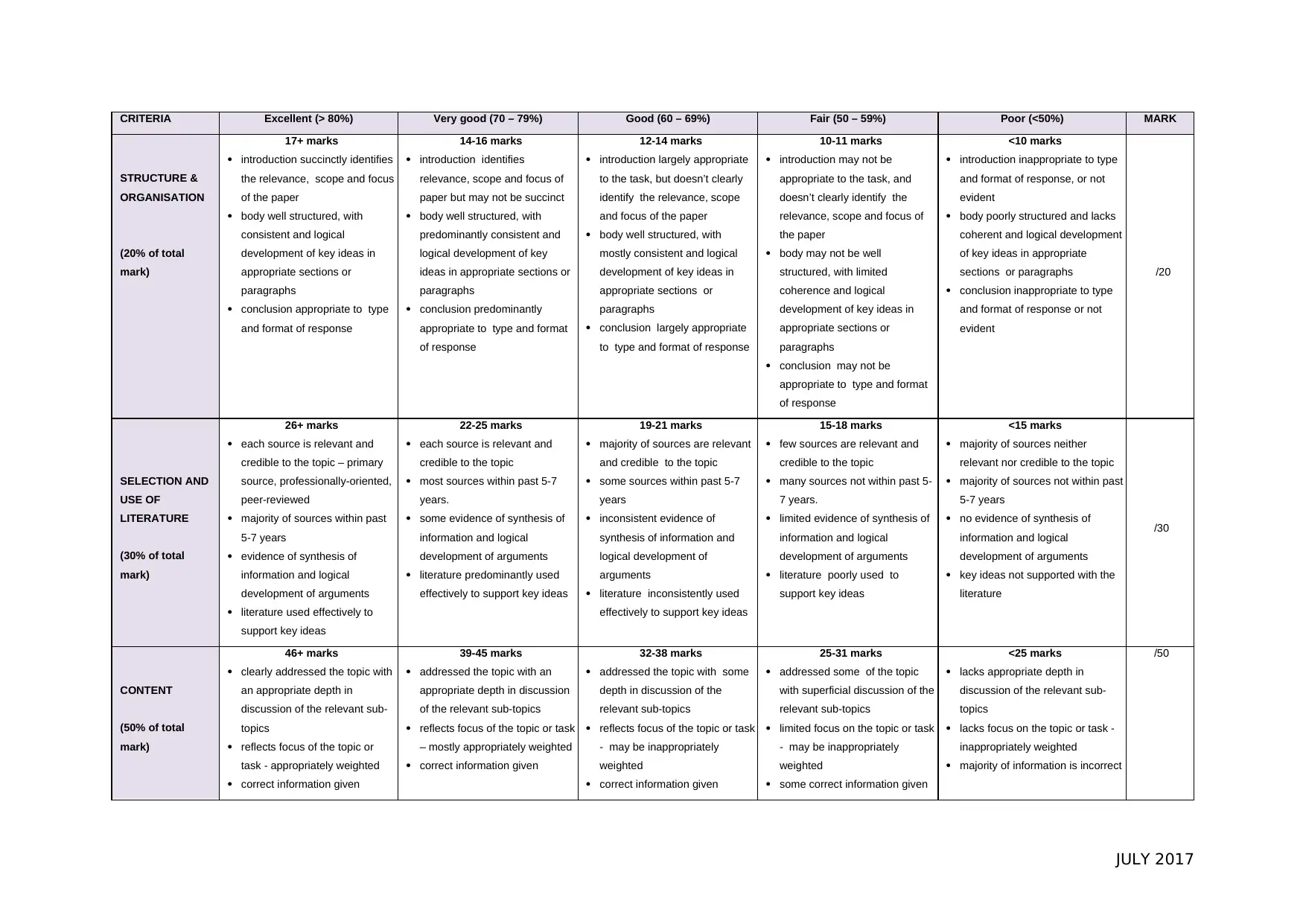
CRITERIA Excellent (> 80%) Very good (70 – 79%) Good (60 – 69%) Fair (50 – 59%) Poor (<50%) MARK
STRUCTURE &
ORGANISATION
(20% of total
mark)
17+ marks
introduction succinctly identifies
the relevance, scope and focus
of the paper
body well structured, with
consistent and logical
development of key ideas in
appropriate sections or
paragraphs
conclusion appropriate to type
and format of response
14-16 marks
introduction identifies
relevance, scope and focus of
paper but may not be succinct
body well structured, with
predominantly consistent and
logical development of key
ideas in appropriate sections or
paragraphs
conclusion predominantly
appropriate to type and format
of response
12-14 marks
introduction largely appropriate
to the task, but doesn’t clearly
identify the relevance, scope
and focus of the paper
body well structured, with
mostly consistent and logical
development of key ideas in
appropriate sections or
paragraphs
conclusion largely appropriate
to type and format of response
10-11 marks
introduction may not be
appropriate to the task, and
doesn’t clearly identify the
relevance, scope and focus of
the paper
body may not be well
structured, with limited
coherence and logical
development of key ideas in
appropriate sections or
paragraphs
conclusion may not be
appropriate to type and format
of response
<10 marks
introduction inappropriate to type
and format of response, or not
evident
body poorly structured and lacks
coherent and logical development
of key ideas in appropriate
sections or paragraphs
conclusion inappropriate to type
and format of response or not
evident
/20
SELECTION AND
USE OF
LITERATURE
(30% of total
mark)
26+ marks
each source is relevant and
credible to the topic – primary
source, professionally-oriented,
peer-reviewed
majority of sources within past
5-7 years
evidence of synthesis of
information and logical
development of arguments
literature used effectively to
support key ideas
22-25 marks
each source is relevant and
credible to the topic
most sources within past 5-7
years.
some evidence of synthesis of
information and logical
development of arguments
literature predominantly used
effectively to support key ideas
19-21 marks
majority of sources are relevant
and credible to the topic
some sources within past 5-7
years
inconsistent evidence of
synthesis of information and
logical development of
arguments
literature inconsistently used
effectively to support key ideas
15-18 marks
few sources are relevant and
credible to the topic
many sources not within past 5-
7 years.
limited evidence of synthesis of
information and logical
development of arguments
literature poorly used to
support key ideas
<15 marks
majority of sources neither
relevant nor credible to the topic
majority of sources not within past
5-7 years
no evidence of synthesis of
information and logical
development of arguments
key ideas not supported with the
literature
/30
CONTENT
(50% of total
mark)
46+ marks
clearly addressed the topic with
an appropriate depth in
discussion of the relevant sub-
topics
reflects focus of the topic or
task - appropriately weighted
correct information given
39-45 marks
addressed the topic with an
appropriate depth in discussion
of the relevant sub-topics
reflects focus of the topic or task
– mostly appropriately weighted
correct information given
32-38 marks
addressed the topic with some
depth in discussion of the
relevant sub-topics
reflects focus of the topic or task
- may be inappropriately
weighted
correct information given
25-31 marks
addressed some of the topic
with superficial discussion of the
relevant sub-topics
limited focus on the topic or task
- may be inappropriately
weighted
some correct information given
<25 marks
lacks appropriate depth in
discussion of the relevant sub-
topics
lacks focus on the topic or task -
inappropriately weighted
majority of information is incorrect
/50
JULY 2017
STRUCTURE &
ORGANISATION
(20% of total
mark)
17+ marks
introduction succinctly identifies
the relevance, scope and focus
of the paper
body well structured, with
consistent and logical
development of key ideas in
appropriate sections or
paragraphs
conclusion appropriate to type
and format of response
14-16 marks
introduction identifies
relevance, scope and focus of
paper but may not be succinct
body well structured, with
predominantly consistent and
logical development of key
ideas in appropriate sections or
paragraphs
conclusion predominantly
appropriate to type and format
of response
12-14 marks
introduction largely appropriate
to the task, but doesn’t clearly
identify the relevance, scope
and focus of the paper
body well structured, with
mostly consistent and logical
development of key ideas in
appropriate sections or
paragraphs
conclusion largely appropriate
to type and format of response
10-11 marks
introduction may not be
appropriate to the task, and
doesn’t clearly identify the
relevance, scope and focus of
the paper
body may not be well
structured, with limited
coherence and logical
development of key ideas in
appropriate sections or
paragraphs
conclusion may not be
appropriate to type and format
of response
<10 marks
introduction inappropriate to type
and format of response, or not
evident
body poorly structured and lacks
coherent and logical development
of key ideas in appropriate
sections or paragraphs
conclusion inappropriate to type
and format of response or not
evident
/20
SELECTION AND
USE OF
LITERATURE
(30% of total
mark)
26+ marks
each source is relevant and
credible to the topic – primary
source, professionally-oriented,
peer-reviewed
majority of sources within past
5-7 years
evidence of synthesis of
information and logical
development of arguments
literature used effectively to
support key ideas
22-25 marks
each source is relevant and
credible to the topic
most sources within past 5-7
years.
some evidence of synthesis of
information and logical
development of arguments
literature predominantly used
effectively to support key ideas
19-21 marks
majority of sources are relevant
and credible to the topic
some sources within past 5-7
years
inconsistent evidence of
synthesis of information and
logical development of
arguments
literature inconsistently used
effectively to support key ideas
15-18 marks
few sources are relevant and
credible to the topic
many sources not within past 5-
7 years.
limited evidence of synthesis of
information and logical
development of arguments
literature poorly used to
support key ideas
<15 marks
majority of sources neither
relevant nor credible to the topic
majority of sources not within past
5-7 years
no evidence of synthesis of
information and logical
development of arguments
key ideas not supported with the
literature
/30
CONTENT
(50% of total
mark)
46+ marks
clearly addressed the topic with
an appropriate depth in
discussion of the relevant sub-
topics
reflects focus of the topic or
task - appropriately weighted
correct information given
39-45 marks
addressed the topic with an
appropriate depth in discussion
of the relevant sub-topics
reflects focus of the topic or task
– mostly appropriately weighted
correct information given
32-38 marks
addressed the topic with some
depth in discussion of the
relevant sub-topics
reflects focus of the topic or task
- may be inappropriately
weighted
correct information given
25-31 marks
addressed some of the topic
with superficial discussion of the
relevant sub-topics
limited focus on the topic or task
- may be inappropriately
weighted
some correct information given
<25 marks
lacks appropriate depth in
discussion of the relevant sub-
topics
lacks focus on the topic or task -
inappropriately weighted
majority of information is incorrect
/50
JULY 2017

SUBTOTAL /100
Referencing/citations
(up to 4 marks deducted)
APA 6 style not consistently used for citations
APA 6 style not consistently used for reference list - TOTAL
MARKS
DEDUCTED
-
Presentation
(up to 4 marks deducted)
Specified format not used (font, double spacing)
Spelling, typing and/ or grammatical errors -
Word limit
(up to 3 marks deducted)
Word limit - (more than or less than 10% of the prescribed limit) -
ADDITIONAL COMMENTS:
TOTAL MARK
/100
JULY 2017
Referencing/citations
(up to 4 marks deducted)
APA 6 style not consistently used for citations
APA 6 style not consistently used for reference list - TOTAL
MARKS
DEDUCTED
-
Presentation
(up to 4 marks deducted)
Specified format not used (font, double spacing)
Spelling, typing and/ or grammatical errors -
Word limit
(up to 3 marks deducted)
Word limit - (more than or less than 10% of the prescribed limit) -
ADDITIONAL COMMENTS:
TOTAL MARK
/100
JULY 2017
1 out of 6
Your All-in-One AI-Powered Toolkit for Academic Success.
+13062052269
info@desklib.com
Available 24*7 on WhatsApp / Email
![[object Object]](/_next/static/media/star-bottom.7253800d.svg)
Unlock your academic potential
© 2024 | Zucol Services PVT LTD | All rights reserved.

